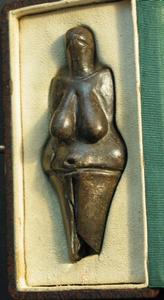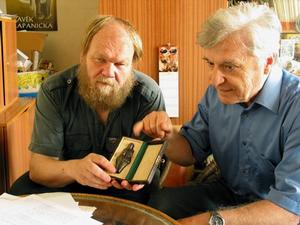Brno, capital of Moravia, Czech Republic, 17 June 2006
Organized within the framework of my meetings with the scientific institutions of the Czech Republic, this visit to the Brno Anthropology Museum will certainly mark a date in my studies on the technological knowledge of prehistoric mankind. Dr. Martin Oliva, paleontologist, presented to me the collection of Paleolithic artifacts – engraved bones – discovered in Moravia, in particular at Dolni Vestonice. Then, in the presence of the journalist of the local national daily and a photographer of Czech Press Agency, he unveiled the queen of his collection, the Venus. I still had for my eyes the image of the yellow limestone Venus displayed at the Vienna Museum, Austria, to be very surprised by this one. It was not worked in soft stone, but manufactured out of terra cotta. Thus, I was looking at the oldest ceramic manufactured by Homo Sapiens 25.000 years ago. (Davidovits, Venus Dolni Vestonice)

Venus from Dolni Vestonice

Dr. Martin Oliva (paleontologist), on the left, and Joseph Davidovits examining the Venus
We have been taught that the terra cotta pottery was not invented before the Neolithic Age, 15.000 years later. And yet, I had in front of me an artifact resulting from the use of fire, at a time when, logically, the prehistoric men did not master this technique, according to the teaching of Prehistory. Like all other Paleolithic Venus, it is only 11 cm high. It is of brown-black color, a color that immediately reminded me of our previous study carried out on Etruscan ceramics (see below). I thus knew how it had been produced: in an open wood fire (a garden fire), at a temperature of 300-400 °C maximum, but with a clay containing natural chemical ingredients, such as alkaline soluble salts, generating a geopolymeric reaction, which I call in my technical jargon, the L.T.G.S. (Low Temperature Geopolymeric Setting of ceramic; see the Geopolymer Institute internet page on that subject). To obtain this terra cotta, one starts with a clay that contains natural salts such as natron, sodium carbonate CO3Na2. This type of clay is very often found in the countries of the Middle-East. It should have been naturally occurring in the area of Dolni Vestonice. A second possibility was the addition to any clay type of an other alkaline soluble salt, the salt kali, potassium carbonate CO3K2, found in ashes of certain plants, like the fern. Then, lime was added to the clay, a type of ash-lime extracted from wood ashes (like the oak). Thanks to these ingredients, the clay will be “fired” at a low temperature of 300 °C, in a simple garden open wood fire, burning dry plants or small tree branches. Well, Dr. Martin Oliva stated that ashes were detected inside the venus body and thus confirmed the geopolymeric nature (LTGS) of the fabrication steps. This is an ultra simple technology, that only works in association with a type of clay and natural chemical ingredients. One obtains a solid terra cotta, of brown color. The contact with the smoke of the wood fire will produce the black shades, by carbon deposition in the pores of the terra cotta. This technique is explained in a scientific publication that I presented with my son Frederic at the 2nd International Conference on Geopolymers, in 1999, See on the site of the Geopolymer Institute, the paper on The making of brown-black ceramic in Prehistory and Antiquity
 In English
In English En Français
En Français